Have you ever pondered the true essence of sustainability? It’s more than a buzzword; it’s a commitment to future generations. Understanding sustainability involves grasping three core principles that pave the way for sustainable development.
In this introduction to sustainable development, we unravel its significance, explore the circular economy, and tackle the hurdles of corporate sustainability. I’ll showcase real-world examples from various sectors, illustrating how embracing sustainability isn’t just beneficial but crucial for businesses aiming for long-term success.
Key Takeaways
- Sustainability has environmental, economic, and social dimensions.
- Aims for responsible resource use, ensuring future generations’ needs.
- Employs sustainable practices across various sectors for holistic benefits.
What is Sustainability? EASY definition of Sustainable
Sustainability is the ability to keep pretty much indefinitely a certain level of something. In modern society sustainability typically refers to the capability to support on an ongoing basis a certain quality of life, economic growth or other socio-economic/environmental status quo.
The most popular and EASY definition of sustainability came from the Brundtland report, titled “Our Common Future” and published by the United Nations in 1987: “meeting the needs of the present generation without compromising the ability of future generations to meet their needs”. Another way to define what is sustainable, as intended today, is the ability of the biosphere to coexist with the human species.
Ecologists and environmentalists use to define what is sustainable in a slightly different way: they observe that the natural environment always tends to achieve equilibrium by balancing the available resources and the different species.
Thus sustainability can be obtained by not depleting all the available resources quicker than they can be naturally regenerated by the planet.
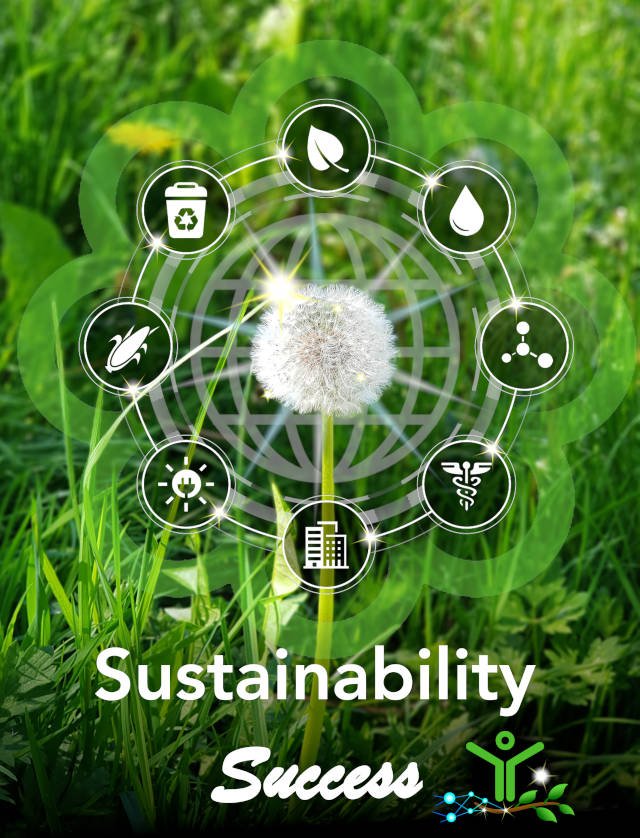
Etymology of Sustainability
To fully comprehend the meaning of a word, it is always useful to know its origins and the original concept behind it. Looking at the etymology of sustainability: it is originating from the Latin verb sustentāre, which means to “support”, “hold up”, “keep up” or “care”.
The verb originates from sub-tenēre, meaning to take from below, then followed by bili-ty, which are elements deriving from the word “possibility”, giving a sense of opportunity. The word “sustainable” instead takes the form of an adjective by using the suffix -ble, which originates from the Latin suffix -bĭlis.
The origin of the word sustainability is also suggesting a balance between the force keeping up an object and its weight pulling it down. This is also supporting the idea of sustainability as an equilibrium between natural elements as suggested by the environmentalists and ecologists.
Finally, many look at sustainability as defined by the three interconnected domains or pillars of society, economy and environment. Under this definition, to be sustainable, it is necessary to reach some equilibrium between the 3 principles.
In more crude interpretations of this systems view, those three domains have all the same importance and should be balanced equally. Other interpretations may instead prefer to give different weights to the three principles.
Is the idea of sustainability new?
The idea of sustainability, while developed mostly in recent decades, is not new. Some ancient cultures already had a conscious approach to the use of resources in their traditions, such as the Maoris of New Zeland, as well as other populations of Oceania, Mali and India.
More recently, after 1662, due to the concern over the depletion of timber in England, planting trees started to be considered a sort of national duty. This then led to plans for sustainable forest management in Europe as well.
Let’s have a look more in detail at two other examples in history: the deforestation of Mauritius and the unsustainable agriculture of the Mayan civilization in the Yucatan peninsula.
Examples from history: deforestation in Mauritius
There are numerous examples of the consequences of the excessive use of natural resources in history, as the depletion of the indigenous forest of Mauritius, which was cut down almost completely between 1639 and 1875. The massive deforestation lead also to issues with the water supply and for this reason, in 1880 a re-forestation plan was implemented.
With the reforestation, new species of trees were introduced on the island while the native forest was mostly lost forever. Today only 2% of Mauritius’s forest is indigenous, while the rest is composed of alien species.
Recent research by S.J. Norder and others suggests that the massive deforestation of Mauritius has still an effect on the soil loss of some areas of the island today. This, together with things like open pit mining and its devastation to the environment, is just another example of how unsustainable development can lead to long term consequences.

Examples from history: Mayan unsustainable agriculture
Another popular example is represented by the Mayan civilization in the Yucatan peninsula, which was already weakened by its unsustainable agricultural practices well before the arrival of the Europeans in the region.
The Mayan population was heavily relying on the culture of corn, but this was farmed unsustainably: they were cutting and burning growing portions of the forest on which the population was depending for resources.
This continued until most of the forest in the Yucatan peninsula was burned and became difficult to produce enough corn to feed the population. This should serve as a reminder that if we insist on unsustainable practices, sooner or later we may suffer the consequences of such a short-sighted approach.

Introduction of Sustainable Development
In this introduction on sustainable development, we will look at its concept and definition, as well as the UN goals for 2030. Then in the next section, we will see how sustainable development can be achieved when all the 3 principles of sustainability are met.
Sustainable development is a principle according to which the goal should be to meet the human development and economic growth needs without compromising the ability of the ecosystems to provide the necessary resources to achieve it. Sustainable development is often seen as the organizing principle to improve certain aspects of sustainability.
What’s the difference between sustainability and sustainable development? While sustainability looks more at the current moment and how to achieve a sustainable economy and society, sustainable development is more oriented toward the long-term implementation of this vision.
Moreover, by adding the idea of “development” coupled with sustainability, sustainable development aims not only at keeping the current quality of life around the world but also to improve upon it while reducing the impact on the natural environment.
17 Sustainable development goals

After the Brundtland Report, the definition of sustainable development has evolved further to focus more also on inclusivity and sustainable economic growth for the planet. This evolution lead to the current 17 sustainable development goals (SDGs) [2] published by the United Nations in agenda 2030:
- No poverty
- Zero hunger
- Good health and wellbeing
- Quality education
- Gender equality
- Clean water and sanitation
- Affordable and clean energy
- Decent work and economic growth
- Industry, innovation and infrastructure
- Reduced inequalities
- Sustainable cities and communities
- Responsible consumption and production
- Climate action
- Life below water
- Life on land
- Peace, justice and strong institutions
- Partnerships for the goals
Those goals are monitored annually by the United Nations in their High-Level Political Forum On Sustainable Development and an online tracker is also available for convenience. The tracker is used as a tool for accountability, reminding everybody that many steps are still necessary to achieve the 17 sustainable development goals by 2030.
Criticism of the sustainable development principle
Some critics argue that the idea of sustainable development has an inherent contradiction because it is bringing together the idea of increased quality of life (development) while using fewer resources.
The flaw behind this idea is that it doesn’t take into account the improvements in how effectively the natural resources can be used thanks to the progress of technology. For those reasons, the idea of sustainable development is mostly accepted as achievable and also adopted by international organizations such as the UN.
3 Principles of sustainable development: People, Profit, Planet
What are the 3 types of sustainability? The three pillars of sustainability, as also outlined in the United Nations Millennium Declaration, are the economy, society and the environment.
Those are often also referred to as people, profit, planet. According to this definition, the 3 principles of sustainability are seen as interacting with each other at the same level and where sustainable development resides at the intersection of the 3.
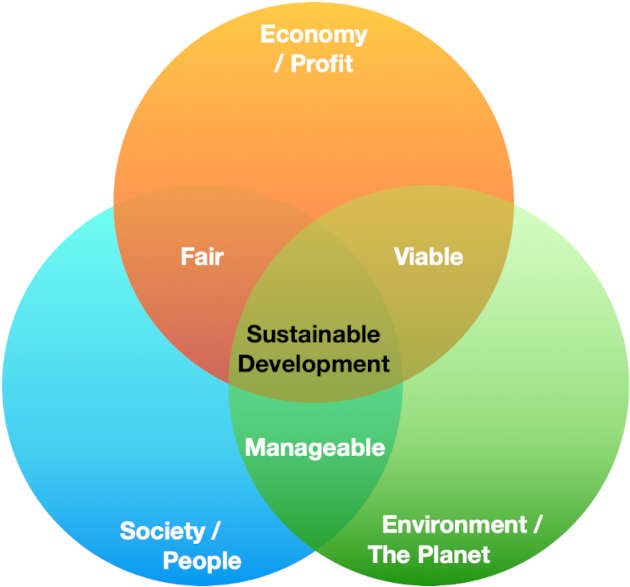
More sophisticated interpretations are also recognizing that the three principles of people, profit, planet are not all at the same level but there is a hierarchy, where the economy is contained in the society and the society is itself contained in the environment.
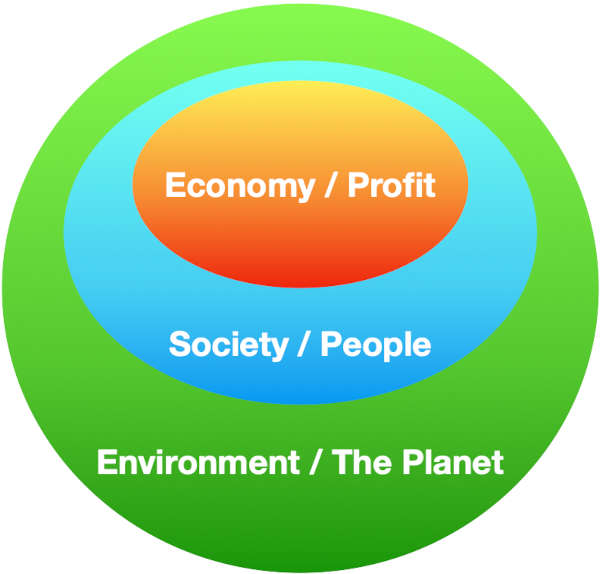
The 3 principles of sustainability or 3 P’s have been used as a guide to define several common standards and certifications. These include Fairtrade, the Rainforest Alliance, GLOBALG.A.P. and UTZ Certified, spanning from sectors such as agriculture, fisheries, forest management, and mining operations.
Those certifications are playing an important role on only in measuring objectively the adherence to sustainable practices for businesses, but also in communicating to the consumer which items are sustainably manufactured or produced.
In recent years the public has become more and more conscious about the importance of sustainability, with damages to the reputation of companies that are keeping a short-sighted approach focusing purely on profit without consideration for the environment.
This led to an ever-increasing number of businesses and corporates committing to reach ambitious sustainability goals in the coming years. Those goals span from zero-emissions commitments to fight climate change to the pursuit of ethical manufacturing, inclusivity, and more.
There is also a less known framework for sustainable development called the four pillars of sustainable development. I wrote a separate article about it, in this variation, there is more weight placed on the human factor.
1st Pillar – Environmental Sustainability: the planet

Environmental sustainability involves the management of land, freshwater, oceans, forests, and the atmosphere. This principle involves direct management of the environment with things like planting and preserving oxygen producing trees and taking action on the human consumption side.
Environmental management involves the use of environmental science and conservation biology to manage at a high level the allocation of resources such as land, water, and emissions to achieve a sustainable future.
This process takes also into account the resilience of the ecosystems and their capacity to absorb disturbances caused by human activities.
The other approach is to manage the demand side of resources coming from human activities. This involves things such as:
- Energy consumption: incentivizing the migration towards renewable sources and improving efficiency.
- Waste management: moving away from a linear model (where the materials end up in a landfill) and promoting a circular path, where recycling is used as much as possible.
- Food: promoting more healthy and sustainable diets, such as the Mediterranean or Japanese diets, that make less use of animal products.
- Freshwater: efficiency is improved by upgrading infrastructure and using new and more efficient technologies, especially in agriculture. Managing also the demand side, by educating the public on the use of this precious and limited resource.
- Reducing CO2 emissions: by making extensive use of renewable sources, improving efficiency, and upgrading to new technologies.
- Population: statistics demonstrate that most of the world’s population growth is coming from the poorest areas of the planet. While the population of the reachest nations remains mostly stagnant or in slight decline. Promoting equality and better living conditions for the poor is not only ethical, but it can also contribute to reducing the global growth of the population.
- Cities: proper planning of the urban spaces and infrastructure can help to achieve more sustainable lifestyles.
2nd Pillar – Economic Sustainability: Profit
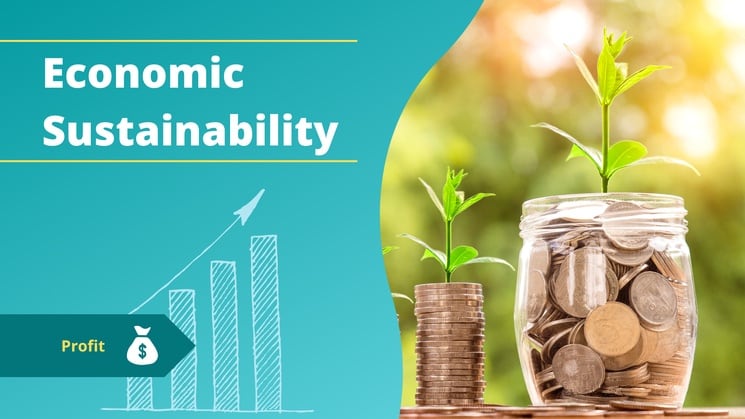
Profit is essential for the business’s existence: a business needs to be economically viable to be sustainable. At the same time, a sustainable business should look at profitability as just one component of the company’s strategy.
A conscious business leader aiming at sustainability should encourage a more balanced culture, where also the social and environmental factors are taken into consideration together with profitability.
Keeping in mind the limits of the planet’s resources is key, especially considering that the current economic model is still based on “infinite” exponential growth. The limited resources available in the environment are not factored in: this is the main problem faced when trying to achieve long term economic sustainability. There can’t be long term economic growth if we deplete all the available natural resources.
The capitalist system based on the free market is an incredible tool to improper the standards of living of western nations, however, this doesn’t take into account the limits of our planet: or better, it doesn’t until it will be too late.
For example, a factory that is using non-renewable resources is penalized because of this, and the damage made is somehow passed on to the collectivity, as a result, the price of their final product will not be influenced by their unsustainable practices. The business doesn’t have a direct economic incentive in adopting more sustainable practices.
One way around this problem is to use government regulations to incorporate the damage made to the environment into the price. This can be done through taxation and incentives: the government can impose a tax on unsustainable practices, such as emissions or excessive waste dispersed into the environment, while it can give a subsidy to more virtuous businesses.
Another concept that is being studied is the opportunity for decoupling economic growth from the degradation of the environment. This means that an increase in GDP would not necessarily mean increased pressure on biodiversity and ecological systems.
This of course requires taking a more long term view of the economic activity and leveraging the available technology, but at the moment, while achievable in some cases, it’s hard to obtain at a global level.
In recent years, thanks also to the increased environmental awareness of the public, sustainable business practices started to gain more traction. This generates new opportunities for businesses and corporates that are interested in embracing a sustainable business model.
Nowadays many businesses are trying to improve the perception of their brand by incorporating sustainability into their business plan. This is leading to new and more conscious leadership, that, by improving the efficiency of different processes, is often able to improve sustainability without necessarily increasing the cost of the final product.
What is the circular economy?
The circular economy is a new model of production and consumption that aims at improving sustainability by promoting: sharing, repairing, refurbishing, reusing, and finally recycling as much as possible of each product.
The circular economy aims at maximizing the use of manufactured products by sharing and leasing instead of owning them: essentially turning products into services. Just think about how many items you own but rarely use, wouldn’t make more sense to lease them only when needed?
Another important aspect of the circular economy is the design process. Products should be designed to be long-lasting, easy to fix, and recycle when their lifecycle comes to an end. For this reason, having a circular economy also implies having a circular supply chain.
What’s the difference between the circular and the linear economy? The circular economy concept is opposite to the one of the linear economy. In a linear economy, all the resources are pulled from the environment to produce goods that have a relatively low average use and are ultimately destined to landfills.
The objective of a circular economy is to create a closed-loop, where most of the resources are reused through recycling and the manufactured product is used as much as possible by extending its life using remanufacturing and refurbishment.
Also in the circular economy, there will be a residual waste, but this will be minimal compared to a linear economy. The graphic below illustrates the differences between linear and circular economies.
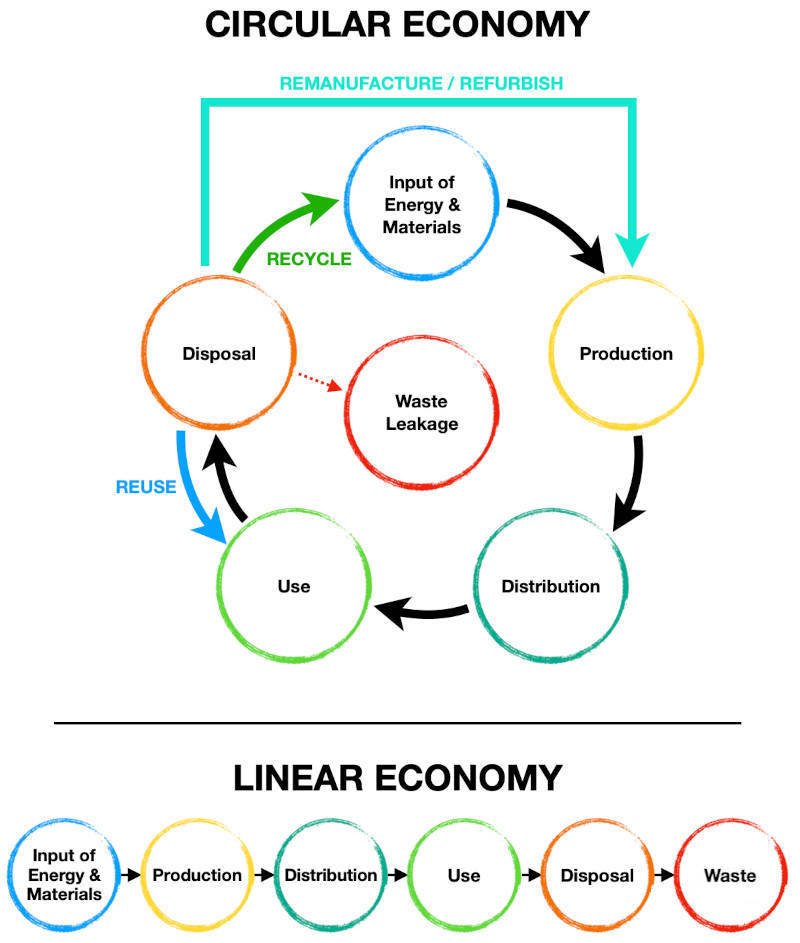
Criticism of the circular economy concept
Recent years saw the rise of several critiques of the circular economy model, let’s have a quick overview of the more interesting ones:
- Some criticize that the circular economy is still privileging continuous economic growth and just trying to improve the sustainability of the current linear model without really addressing the main issue.
- Corvellec, Hervé (2019) are focusing on the unavoidability of waste, which should somehow be considered an inevitable byproduct of life. While in the circular economy, waste is considered a sign of failure.
- Geyer and Zink (2017) are questioning the central assumption of the circular economy. Arguing that reusing and recycling may not be preventing the production of new goods due to economic reasons that are not considered in the circular economic model.
- Perhaps the most interesting critique comes from Korhonen, Jouni; Honkasalo, Antero; Seppälä, Jyri (2018) who argue that the circular economy model is violating the second law of thermodynamics. According to this fundamental law of physics, all spontaneous processes tend to equilibrium and lead to an increase in entropy. In other words: when trying to implement the circular economy in the real world, it will not be viable to recycle or reuse all the materials. Recycling all the materials would ultimately require systems that will use more energy than what those recovered resources will be worth. As a consequence, we will still have parts of the economy following the linear model.
While the circular economy concept is far from being perfect or the solution to all of our ecological concerns, we still have to recognize that we have no excuse to not pursue more efficiency in how we use and produce things.
In this regard, the circular business model is helping to give us a framework to focus the attention on optimizing product design and also to reduce the impact on the environment.
3rd Pillar – Social Sustainability: The People
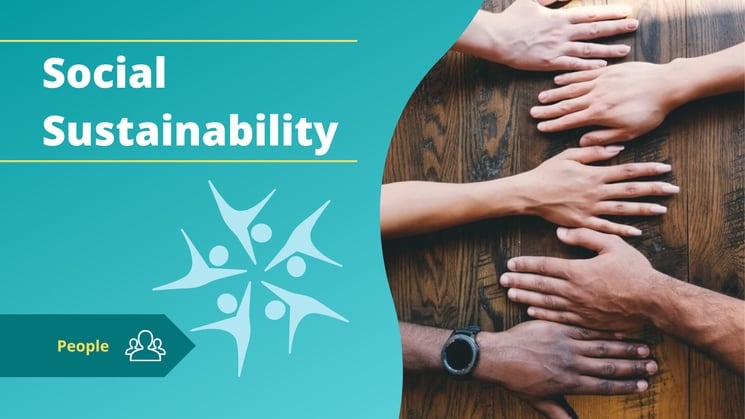
Social sustainability includes things such as fighting poverty, social justice, peace, promoting diversity, quality of living, access to healthcare, education, community development, cultural sustainability and heritage and some aspects of religion.
Unfortunately, this is the least defined and understood compared to ecological and economic sustainability. However, the social factor is influencing all human activities and as such, it is strongly linked also to the economic and ecological dimensions of sustainability and sustainable development.
Let’s look more in detail at the main aspects of this type of sustainability:
- Peace, security, and human rights are very important components of social sustainability, this is because wars, crime, and unethical practices are not only wasting valuable resources in destructive activities but are also ultimately bad for the environment. Just think about all the pollutants dispersed into the environment during wars or from factories using unethical practices.
- Access to healthcare is a central point of the social principle. Many health-related issues are interconnected with the environment and economic aspects in general. For example, in agriculture, green improvements are also helping to improve health-related conditions. Finally, the World Health Organization is going as far as considering sustainability impossible to achieve without taking care also of health-related issues.
- Poverty and social justice: poverty and lack of social justice are also not allowing societies to make long term plans, ultimately reducing human wellbeing while also hurting the environment.
- Influence of religion and culture: cultural sustainability deals with beliefs, religion and heritage conservation. Cultural aspects are without a doubt one of the drivers that can help to enable sustainable development. In this respect, recent years saw some important contributions on the religious side that helped to attract more attention to the topic: with both the Dalai Lama and Pope Francis calling for more responsibility in fighting ecological degradation and preserving the ecosystems.
Other important Concepts
To better understand the 3 principles of sustainability we need to consider also some additional concepts like the main factors influencing human impact on the environment, the resilience of the ecosystem and the ecological footprint, or better, the idea of Earth’s carrying capacity.
Human impact on the environment
The human impact on the environment is a major factor in the depletion of natural resources and the destruction of ecosystems and biodiversity. To better understand the main contributors to the impact of humankind on our planet’s ecosystem, it is useful to refer to one of the first ways to measure this.
At a very high level, the human impact depends on 3 major components: population, level of consumption and the available technology.
The size of the world population is an obvious driver acting directly on the extent of the resources used by mankind and also the amount of waste. At the same time, the average level of consumption of the population plays a vital role: a tribe living in the forest would not use anywhere near the resources consumed by an average citizen of the western world.
Finally, the available technology has also a fundamental influence: the proper application of recycling strategies and the use of renewable energy can greatly reduce the resources consumed by modern citizens of western nations.
Ecological footprint: the Earth’s carrying capacity
The Earth’s carrying capacity is defined as the size of the population that the ecosystem can support. This is usually obtained by evaluating the resources available for each individual in terms of hectares of land.
The calculation is considering resources like accommodation, food, the capability to absorb waste and CO2 and more. Recent calculations show that each person has about 1.6 hectares of land available on the planet before starting to use non-sustainable resources. Unfortunately, the current average ecological footprint per capita is about 2.8 hectares of land, which is way past the sustainable limit.
The scientific research behind the Earth’s carrying capacity idea is reported in detail in the “Millennium Ecosystem Assessment”, published by the U.N. in 2005.
Once passed the planet’s carrying capacity, the existing population can not be sustained without access to non-renewable resources or using available stock of goods and services.
As a result, the “ecological deficit” must be met by using resources that were accumulated in the past, such as fossil fuels or available stock of products, or resources borrowed from the future, by overexploiting forests and fisheries.
It is worth noting that we are exceeding the available planet’s carrying capacity mostly because of the over-consumption of the more advanced economies, so it is crucial to reduce the ecological footprint of those countries.
This can be achieved by promoting the use of new and more efficient technologies as well as implementing more comprehensive strategies to reduce the human ecological footprint at the local and global levels.
Corporate sustainability and sustainable business
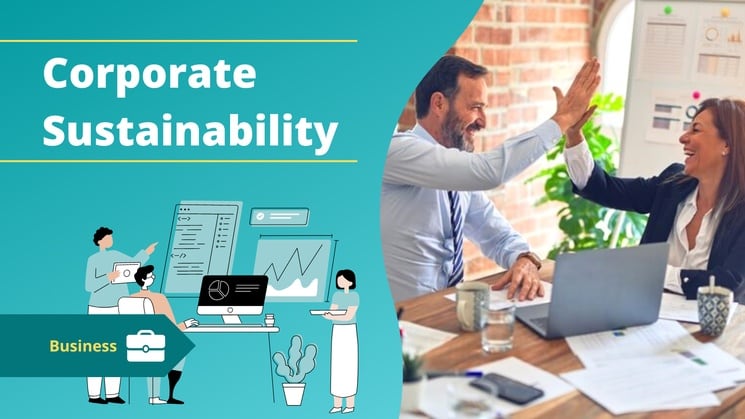
Corporate sustainability is aiming to create long term value by promoting transparency and implementing a vision encompassing social, ethical, economic, and environmental objectives.
In other words, this requires thinking about the broad long term impact of the business on the environment and society rather than just focusing on short term economic interests.
To achieve this, it is necessary to have a sustainable business plan keeping in mind the company’s environmental responsibilities and engage with the company’s stakeholders to implement the green long term strategy.
How important is corporate sustainability?
Corporate sustainability is of course a very important aspect to be able to achieve a green economy. This is because large corporates can have an immense influence on society thanks to their vast operations and resources.
Some large international companies such as Amazon, Apple or Google can have more resources than some small countries, and their know-how & technology can be of great help if applied with a long term sustainable development goal.
On the other hand, we also have society pushing for more sustainable business. This constitutes an incentive for corporates to show concern about the environment and society in general because failing to do so would lose them the public trust that they gained over many years of being in business.
Sustainability is a vision that many executives would like to see implemented to transform the world into a place where not only a few can enjoy a good quality of living but where the wealth is more equally distributed.
This while also making sure to preserve as much as possible biodiversity and the environment, avoiding inefficiencies and waste of precious natural resources. It’s a vision of a fairer and more resilient world that is not somehow stealing the future of our children.
Finally, evidence shows that, in the long run, businesses can benefit financially by being more green and caring for the greater good:
- Attracting talent: motivated and creative professionals are more and more evaluating the attention to the environment of potential employers.
- Efficiency: improving the product designs to increase energy efficiency and reduce waste can provide savings and also give a competitive advantage to the final product.
- Attracting investments: the Environment, Social, and Governance metrics (ESG metrics) are increasingly taken into consideration when trying to secure new investments to grow the business.
Sustainability for small businesses: difficulties and opportunities

While large companies can have the resources and capability to become more sustainable, for small and medium businesses this could be more challenging. At the same time, to achieve sustainability, SMEs need to be involved it is estimated that about 95% of the companies worldwide are micro, small or medium enterprises.
In addition, SMEs are also responsible for more than half of the jobs, so their contribution to society and the economy is very important.
Given the number of small and medium businesses, while their impact on the environment may seem negligible when you consider them as an aggregate, they have a significant impact on the environment. For this reason, those companies must include sustainability in their agenda.
However, SMEs operations are often managed more informally and simply, for this reason, including also the impact on the environment as a factor to consider, can be difficult. Some may even think that their impact on the environment is minimal or that it would be too costly for them to implement sustainable operations and production.
On the other hand, incorporating sustainability in SMEs can have long term benefits, such as lower costs, new opportunities, improved brand reputation and reduced overall risk.
With a growing interest in sustainable business from large corporates and governments, embracing sustainability can help SMEs to open some new doors and possibly grow their business because those large entities will be more willing to work with them.
Despite the benefits, for many small businesses becoming more green is a quite difficult task, because it is hard to get reliable information, look for new potential suppliers or work with the current ones to find solutions that are more friendly for the environment.
difficulties faced by Micro & small Businesses when implementing Sustainable development
One example that for sure will apply to many small businesses regards packaging: in some cases, it is extremely difficult to not make use of plastic, as the real alternatives may not be readily available at an affordable price for small orders.
Often is very hard to get rid of plastic packaging, especially when you need to protect the product from humidity and potential mold issues. Probably with time alternatives to plastic packaging will become easily accessible, but at the moment, this is a quite challenging topic.
Another example is the choice of the country of manufacturing: a more sustainable choice would be to look for local suppliers, close to the region where the final product will be sold.
This would reduce the impact of emissions due to transportation. However, if the product is sold in Europe or the US, a small business will definitively struggle to even get in touch with any local factories, let alone place any small order.
In addition, for small orders, the cost of sourcing a product made in the USA or the European Union would be prohibitive for a small business. As a result, often small and micro businesses have no other choice other than sourcing their products from countries like China India, or others, where not only do the items have a more competitive price but where it is also possible to interact with suppliers even if you are a small fish.
This doesn’t mean that small businesses can’t do anything to be more sustainable, for example, managers can make sure that their suppliers are ethical and treat their workers fairly.
Or they can for example make sure that the suppliers are not using chemicals that are dangerous to the environment by doing lab checks on the final product. Those things will be costly, but in the long run, will benefit the brand reputation and perception by the public.
An excellent example of what small businesses can do to be more sustainable is Relixiy, an SME based in the United Kingdom, and selling an ethical and eco-friendly weighted blanket in the UK. This is the demonstration that also small local businesses can do their part for the environment.
Regarding medium size businesses instead, they already have enough financial resources to look into renewable energy and reduction of their carbon footprint. This investment would be significant, but it will also help to push down their costs and ultimately make the business more efficient in the long run.
Examples of sustainability: how to achieve sustainable development?
Sustainability requires, first of all, a shift in the business and government leaders’ mindset more toward a long term sustainable vision that allows for the preservation of the world’s resources and ecosystems for future generations.
This involves envisioning and then implementing complex strategies over the next decade or so while also taking care of the usual shorter-term challenges involving profit and loss.
How to achieve sustainable development? The answer to this question varies depending on the sector of the economy we are considering because different industries are generally facing diverse issues and what applies to one is not always applicable to the other.
To better understand this, in this section we will have a quick look at several examples of sustainability. Of course, there are many more examples of sustainable development such as sustainable urban design and sustainable construction materials, for which I wrote more detailed articles.
Green computing: examples of sustainability in Information Technology (IT)
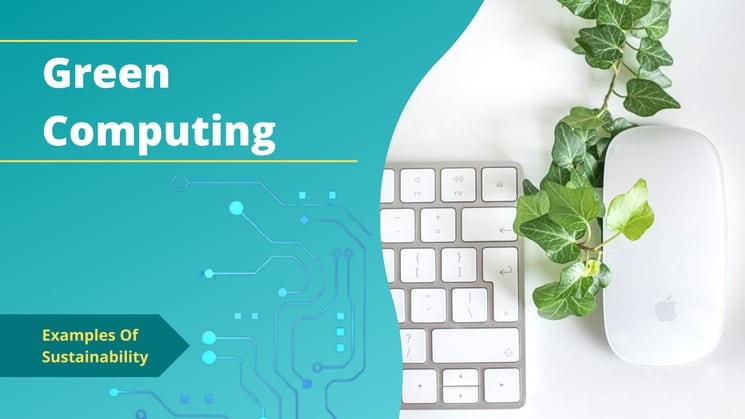
Information technology (IT), in terms of electricity consumption, is responsible for about 1.4% of the CO2 emissions worldwide. Pursuing green information technology by reducing the emissions directly generated by the IT sector is very important, however, some additional factors need to be considered when evaluating the overall environmental impact of this sector.
First of all, how is the device manufactured? Is the device manufactured using renewable energy and recycled materials when possible? Are any dangerous substances released into the environment during the production? What’s the energy consumption of the finished product? How long is its lifecycle? Is the device easy to disassemble and recycle?
Unfortunately, come fundamental components of many IT devices contain some rare or exotic materials that are often difficult to get back for recycling once the product is disposed of.
There are a lot of efforts to make IT greener and those are the most important questions we should ask ourselves when evaluating the sustainability of an electronic device. A lot of energy and resources could be saved if the device is energy efficient and sustainably manufactured.
Finding the right equilibrium
Given all the factors at play, being green in IT means finding the right balance between having a long enough lifecycle and eventually upgrading to a new machine when the technological leap is large enough to justify replacing the old kit.
For example, without considering financial factors, if a new server is reducing the energy consumption by 20% for the same computing power, then it is probably worth upgrading your servers pretty quickly.
If on the other hand, the efficiency gain is only 1-2%, then it would be more sustainable to just keep using the servers you already have for a longer time, because the savings in power consumption wouldn’t offset the environmental impact of producing a brand new device. Unfortunately, this type of evaluation is not always easy for non-experts.
The same applies to any other IT device, like smartphones or tablets. In the specific case of smartphones and tablets, nowadays the actual improvements from one generation to the next are not that large anymore. For the average user, the lifecycle of a smartphone, if well made, could be easily extended to 4-5 years without significant performance issues.
For example, I recently refreshed my smartphone after using it for 4 years and, honestly, except for the battery, I didn’t notice any huge leap in performance on the new phone. So if you want to be more sustainable, it is better to avoid changing your smartphone every other year, because, generally, from a performance and environmental point of view, it is not worth it.
Example of improved IT sustainability: the cloud
Another example of how IT can improve its sustainability is cloud computing, before the cloud, a lot of devices in businesses were bought just to be used now and then. But with the advent of cloud computing, it became possible for businesses to just rent the needed time on those devices from a cloud provider.
The cloud allowed to share and rationalize resources that before were inefficiently allocated due to the lack of such a service.
Production: examples of sustainable manufacturing

Sustainable manufacturing requires that all the entities involved in the production are making conscious choices aimed at:
- Reducing the energy consumption necessary for the production of goods.
- Lowering the emissions caused by manufacturing activities.
- Waste management and reduction.
- Reducing the water consumption necessary for manufacturing.
The most effective way to achieve this is always to start from the beginning of the entire process: product design. The designers should take into account the entire lifecycle of the item, aiming at lowering the environmental impacts at every step. The production engineer should for example look at things such as:
- Material substitution: giving preference to less polluting options while retaining performance and competitiveness.
- Easy to disassemble products: this can have a big impact on the possibility to repair, reusing, and recycling the product. Maximizing the lifespan of the item and reducing the waste destined for the landfill once the product’s life will come to an end.
- Manufacturing processes: privileging less energy-intensive production methods can help to reduce the energy consumption and emissions of the manufacturing activities. The designer will also have to take into account that different design choices can have a big impact on the possible production methods to choose from.
Upgrading the machines used for manufacturing with new devices. For example a Kinetic Energy Recovery System (KERS) can for example allow recovery and reuse of some kinetic energy that otherwise would be wasted. Enabling improvements in energy efficiency and consequent reduction of emissions.
Additional improvements can also be achieved on the software side: optimizing the software’s use of resources (or developing new software solutions) to achieve the same or better final result by using less energy or wasting fewer materials.
Improved sustainability is one of the benefits of the fourth industrial revolution and its associated digital transformation. Thanks to those technologies manufacturing lines can become much more efficient, reducing waste and improving quality.
This can apply to both an entire manufacturing plant (by transitioning towards smart production methods and more automated factories), by optimizing the overall interaction of all the machines involved in the production process or at the single machine or tool level, for example by optimizing the steps taken to produce a particular component: like tooling path optimization, efficient tool replacement schedule, etc.
Transport: examples of sustainable mobility

The transport sector is accounting for about 21% of global emissions, making this one very important area of action to achieve sustainability. Sustainable mobility aims at improving energy efficiency and reducing the greenhouse gas emissions generated to move goods and people around.
This involves also promoting alternative means of travel by inviting people to walk and cycle more, increasing the use of public transport, and so on as an alternative to private cars. As well as promoting green tourism, ecotourism, geotourism, for sustainable laisure travel.
Road transport is responsible for about three-quarters of the worldwide emissions related to the travel sector. About 45% of those emissions are due to cars and buses, for a total of about 7% (in absolute terms) of the worldwide greenhouse gas emissions. For this reason, improving the energy efficiency of this sector is a very important step towards sustainable development.
Did you know that you could save up to 15-20% of gas by using cruise control while driving on a highway? In addition, if you consider new interesting types of car insurance, like Drive Safe and Save, you can save even more fuel as well as get discounts on your auto insurance. Also, simple things like this can help to improve sustainability.
Examples of sustainable transport
Let’s look more in detail at some examples of what we can do to be more green in our mobility:
- Walk more: if you have to go somewhere within 2km distance, plan for a nice walk to get there instead of using a private car. Walking more will not only reduce your ecological footprint but is also very good for your health and wellbeing, by reducing stress, improving the heart function and breathing some fresh air.
- Use a bicycle: cycling is another great way to move sustainably. It is increasing the range you can reach by using only your physical energy. Using a bcycle you can easily reach any destination within 8-10 km in an urban environment and, again, it is also good for your health. To keep the citizens safe while riding their bicycles and to make it more convenient, governments need to create the necessary infrastructure, like dedicated cycling paths or preferential lanes for bicycles.
- Use public transport: if you can’t walk or cycle you can always opt to use public transport. This, compared to using a private car, will reduce the resources needed to bring you to your destination. To encourage the citizens to use more public transport local authorities and governments need to dedicate the right amount of resources to the sector, making it more convenient to use.
A separate section is instead necessary for electric cars.
Electric cars
Electric cars have their pros and cons, but especially they have the potential to possibly help reduce emissions and the overall environmental footprint of the transport sector. Why am I saying “possibly”? Well, the simplistic argument that is usually made by many is that the batteries of those cars can be recharged using renewable energy, so, as a result, they are a green mobility option! Well, it’s not that simple, because:
- Renewable energy covers only a relatively small portion of the currently produced electricity that you are likely to use to charge your electric car.
- Renewable energy is often indicated as the solution to fossil fuels. However, there are significant engineering challenges that we need to overcome first. For example, the intermittent and seasonal nature of sources like solar energy, require additional technology to store the energy and this increases the environmental footprint, especially if we have to use batteries.
- The available battery technology is not good enough yet to achieve sustainable mobility because of: the relatively short battery life span, the considerable environmental impact of the additional mining operations necessary to get the required metals, and the large quantities of batteries that need to be disposed of regularly.
Does this mean that electric cars are not a viable option to achieve sustainable development? No, all it means is that the right technologies are not available yet, but, hopefully, they will get there soon.
For example, important advancements are coming in battery technology: allowing the lifespan of batteries to be extended as much as the lifecycle of the vehicle itself. Another tech currently being researched could allow charging the batteries super quickly: in minutes instead of hours. Finally, more research is being done on alternative and greener materials for batteries and also to further increase the battery capacity.
Also, many people also ask: why can’t electric cars charge themselves? The problem with that is again technology. The tech we have available is simply not good enough to do it.
Another alternative could be hydrogen, but the necessary infrastructure will be very costly and also hydrogen needs electricity to be produced (ie. it is only a relatively convenient way to store energy, not a source).
Regarding the source of energy itself, there are already some alternatives that are free of greenhouse gas emissions. However, those alternatives involve the use of nuclear power, with its pros and cons, that as we currently stand with this technology, is a non-renewable source and produces dangerous nuclear waste as a byproduct.
Hopefully in the future new nuclear technology will allow the reduction of the produced nuclear waste or, even better, if we could find a way to tap into nuclear fusion, we could finally have an unlimited and clean source of energy at our disposal.
In conclusion, key research is still ongoing and, hopefully, we will soon be able to achieve more sustainable mobility thanks to electric cars and hybrid vehicles.
Sustainable Agriculture: examples of Sustainability in the food production

Sustainable agriculture means taking care of the natural resources, ecosystems, and biodiversity that the farms rely upon to produce food. This involves things such as promoting biodiversity and healthy soil, reducing pollution to the minimum, and managing water consumption appropriately.
The fundamental idea to achieve this is to manage the farm as an actual ecosystem: also known as agroecology.
Following this fundamental concept, we can find some examples of practices aimed at improving sustainability in agriculture, such as:
- Integration of animals in crop production: in natural ecosystems, animals and vegetation are coexisting together with mutual benefits. The animals get fed while the plants get fertilized. This contributes to naturally enriching and fertilizing the soil. On the other hand, in traditional industrial farming, the livestock is generally kept far away from the fields where the crops are grown. According to recent studies, smart integration of livestock and crop production can contribute to improving the efficiency of the farms, making them more sustainable and profitable.
- Crop rotation: this can involve both growing multiple crops at the same time on the same soil (intercropping) and annual crop rotation. As a result of rotating crops, a reduced quantity of pests, and the soil is also replenished with nutrients. These techniques are very old as they were already used well before the start of industrial agriculture, which instead relies on the massive use of pesticides and fertilisers.
- Integrated pest management (IPM): this can be achieved in natural ways that don’t involve the use of polluting pesticides. One way to do this is for example by introducing in the crops ecosystem animal species that are predators of the pests that can affect a specific culture.

Those are only some of the sustainable development examples in agriculture, the topic is of course very complex and there are many more steps we should take to achieve the desired target.
Another to promote sustainable agriculture is to start a garden in your backyard. You can avoid using chemicals, buy much less food from the store, save money and eat healthier and more sustainable seasonal food. If you decide to start a garden, you should first learn also about pests and other animals that may affect your plants.
The path towards sustainability: becoming greener
From this introduction to sustainable development, it is clear that the path toward sustainability is still long, complex and very specific for each sector of the economy. However, the rewards for achieving sustainable development and realigning human development with the environment are huge.
The starting point of each revolution is always an idea: sustainability is becoming more and more central in people’s consciences and especially in business and government policies. Thanks to this, progress is being made in all the necessary areas.
Some may say that what is being done is not enough, however, it is clear that humankind finally started this journey and this is a fundamental step towards reaching the final goal.
Education is the starting point for the path toward sustainability. Start by inspiring the right mindset and making eco-friendly considerations that can be applied in the everyday life.
Meanwhile, a lot of green research is underway and many new important green technologies are being developed to help humanity to become more respectful of the environment. Every day we are tapping more and more into renewable energy, developing more energy-efficient products, improving our recycling capabilities, and much more.
Thanks to this and other steps, the world is slowly changing and humanity is becoming more conscious of those topics. So, we may still be far from our sustainable development goal, but we are already on the right path, all we have to do is accelerate our steps and get there as soon as we can.
Learn More
- United Nations sustainable development goals (SGD).
- European Parliament – Circular economy: definition, importance and benefits.
- The Sustainability Institute by ERM.
- Assessing temporal couplings in social-ecological island systems: historical deforestation and soil loss on Mauritius (Indian Ocean) by S.J. Norder, A.C. Seijmonsbergen, Soonil D.D.V. Rughooputh, E.E. van Loon, V. Tatayah, A.T. Kamminga and K.F. Rijsdijk – 2017.

